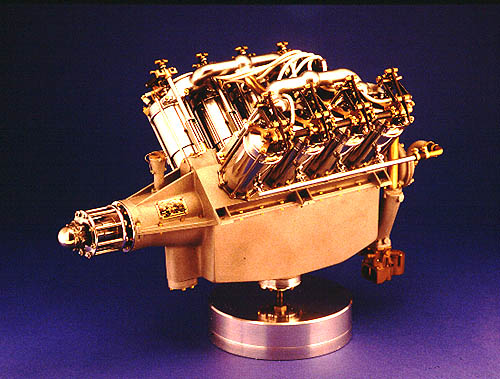

Budd Davisson, Text and Photos
Do you think you've become so blaze' that nothing impresses you any more? Don't feel alone. That's true of most of us. We've become accustom to airplanes which are so finely built, they are almost rediculous in their perfection. We've come to expect each design to be faster, each new avionics package to be lighter and capable of doing much more of our thinking for us. 200 mph has become our base cross country speed and everything has to work up from that.
In short we're a tough audience. To show us something that truly blows us away is next to impossible. But, it is still possible. That's a promise.
Don't believe that? Then take a look at the OX-5 engine Wally and Scott Warner of Replica Engines have in production. If that unbelievably beautiful little bundle of jumping, jiggling and rotating parts doesn't make your mouth water, you really are beyond help.
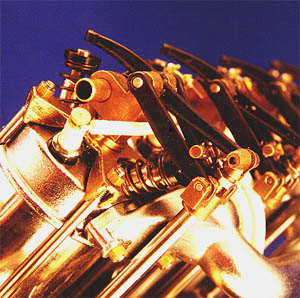
What makes their engine so special? Well, it's an OX-5, which makes it pretty special to begin with. And it runs beautifully, which is also pretty special. But what takes their engine right off the amazement scale is that you can hold it in one hand...it's only 13 inches long and weighs eight pounds.
That's right, it is a 1/4 scale model airplane engine!
What, you may ask, are we doing devoting space to something which might be better covered in a model airplane magazine? Take a look at the accompanying photos and if you have to ask that question, you've once again proven yourself terminally blaze'.
This thing is too neat NOT to let the rest of sport aviation know about!
The OX-5, for those of you who just arrived on this planet from another galaxy, was, in many ways, the cornerstone on which general aviation was built. The product of Glenn Curtiss's love affair with engines which went clear back to the turn of the century, the OX-5 was the most highly produced aviation engine in the country, and probably in the world, at the time. To full-fill the needs of the JN-4D Jennys produced for the US and England, Curtiss and a number of licensees cranked out over 15,000 (some sources say nearly 50,000!) OX-5, water-cooled V-8s between 1914 and 1918.

The incredibly cheap surplus airplanes and engines which flooded
the country after the war did two things for aviation. First,
the inexpensive airplanes exposed a huge number of people to airplanes
in a very short period of time. If the airplanes had been more
expensive, barnstormers would never have been able to survive
and aviation's most immediate public relations tool would have
been short lived. Also many people 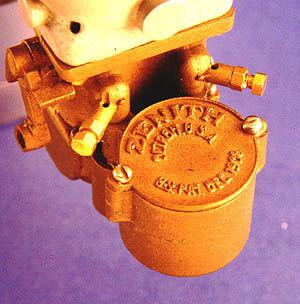 would
have never tried their hands at learning to fly. Secondly, as
the Jennys began to fall apart in the late 1920's, a second generation
of aircraft were designed specifically to take advantage of the
huge supply of nearly free, brand new engines. Dozens and dozens
of designs, including Travelairs, Robins, WACOs and so many others
would never have happened so easily if the engines hadn't been
so readily available at the beginning.
would
have never tried their hands at learning to fly. Secondly, as
the Jennys began to fall apart in the late 1920's, a second generation
of aircraft were designed specifically to take advantage of the
huge supply of nearly free, brand new engines. Dozens and dozens
of designs, including Travelairs, Robins, WACOs and so many others
would never have happened so easily if the engines hadn't been
so readily available at the beginning.
It wasn't a wonderful engine, as we measure engines today, but it was available and it was cheap. Also,when compared to the engines which had gone before, it actually was relatively reliable and efficient. The operative word there is "relatively."
Weighing in at 400 pounds and putting out 90 hp, it included a number of design problems which dogged it most of its life. Although the crankshaft and cylinder assemblies were nearly bulletproof, the cooling, ignition and valve systems were specifically designed to cause headaches.
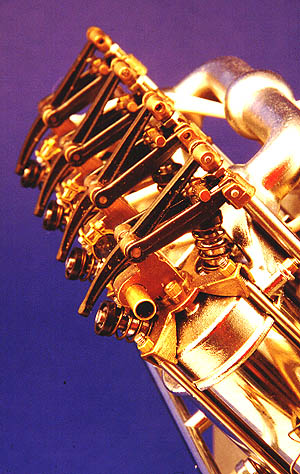
However, before we throw rocks at the engine's weak points we have to put it back in context: The engine was designed to be flown for only 50 hours and then replaced by a military mechanic who may have never actually worked on an engine before joining the service. Overhauling or repairing the engines wasn't an option simply because the field facilities weren't there to cope with them. The goal was to train thousands of new pilots and that meant keeping the Jennys in the air, not in the shop. Since engines were flooding out of the production plants, it was far faster to yank an engine and replace it rather than repair it.
Post-war civilians operating the engine didn't have the luxury of replacing it as easily so they had to live with, and work around, its weaknesses. The valve train was the first thing to fail, assuming the old Berling magneto didn't give out somewhere along the line. The rocker arms had no rollers, so they put side loads on the valves causing them to teeter back and forth which ate valve guides. Then the spindly little valve springs would rust to nothing as soon as the heat and weather got to them. The cylinders and heads were one piece with no separate valve seats or guides, so when a valve guide died the entire jug had to be replaced.
The valve train was so bad the CAA reportedly required all OX-5s to have a valve job every 100 hours if they were installed on licensed airplanes.
A solid aftermarket industry sprang up during the 1920's to supply parts aimed at fixing many of the engine's problems and these included valve guide inserts, rocker arm rollers, a number of different magnetos and on and on.
And then we have the Warners and Replica Engines, Inc.: Why would anyone decide to build an engine with so many parts and then make those parts so tiny?
It's not as if this is the first time they've done something so seemingly crazy nor is it a hobby. For nearly 20 years Wally and his son Scott have made their living and their reputation building motors for the model airplane community. But not just any motors: They specialize in radials, rotaries and the OX-5.

Originally they purchased the rights to an English designed five cylinder radial (about 5 inches in dameter) which they redesigned and then put into production under the name Technopower. Eventually their line included three, five and nine cylinder engines and they became very accepted as reliable model airplane power plants.
But Wally is a real-airplane type of guy, having built one of the very first VariViggins. He built the airplane before he even knew how to fly! Because of his real-airplane background, he saw a market niche in the homebuilt market for a small, four-stroke engine so they sold Technopower and began working on a new line of four-stroke, two-cylinder 50 hp engines. Unfortunately, as with many venture capital projects, those who had the money in it decided to do something else with it and the project was taken away from them after the prototypes were running.
Wally says he is genetically disposed to nuts and bolts and can't stay away from them which may be the reason they then began building a quarter scale Gnome-Rotary Monosoupe engine for the model field. This beautifully done engine is about ten inches across and actually runs. He will even supply a specially designed display case which allows the engine to be run in it. This is, of course, assuming you don't have the guts to stick it in your equally beautifully crafted 1/4 scale Sopwith. Replica Engine's motors are meant to be flown but far more end up on desks.
Don't get the impression that this is a man and his son cranking out one or two engines a year. This is a real engine manufacturing facility which runs its parts 100 sets at a time. Also don't think these engines are cheap!
As the rotary production line settled down and was running smoothly, Wally and Scott began looking around for their next product. They had kicked around a lot of ideas, but then someone mentioned that Glen Courtright had a bunch of OX-5 stuff in his garage.
Wally knew Glen because most of the VariViggin supplies came through Glen's old company, B & F Supplies. They started talking and in a short time the Warners found they had a complete OX-5 scattered around their shop to use in building their tooling.
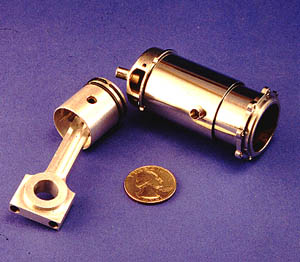 When they built the rotary they
had used a set of existing machine drawings which turned out not
to be totally accurate in all areas. The Technopower engines had
been radials, but they were more of a generic, a-little-like-everything,
engine. They weren't a scale anything. For the OX they took a
different tact.
When they built the rotary they
had used a set of existing machine drawings which turned out not
to be totally accurate in all areas. The Technopower engines had
been radials, but they were more of a generic, a-little-like-everything,
engine. They weren't a scale anything. For the OX they took a
different tact.
"When you're building a multi-cylinder engine, its really not all that much more difficult to replicate every aspect of the real engine," explains Wally.
"Since we had a real live OX-5 as a pattern, we decided to make our engine as accurate to scale as possible."
The original OX-5 had a ton of parts including an induction system which forced the gas vapor to travel nearly four and a half feet to get to the cylinders. Then there was the oddball valve operating mechanism in which a normal pushrod actuated the exhaust valve but the intake was actuated by a housing around the exhaust pushrod which was springloaded to open, rather than close, the intake valve.
"The only area we had to cheat on was the magneto because the parts got so close together we couldn't control the high voltage. So the mag is very slightly larger than scale."
Look at those little, bitty sparkplugs! They make those themselves too!
We've said about all we need to say. Check out the pictures. They tell the entire story.
PS
Did we mention they also have a little Offenhauser four-banger
well underway?
contact:
Replica Engines, Inc.
RR 1, Box 61B
Gulliver, MI 49840
(906) 341-3561www.replicaengines.com